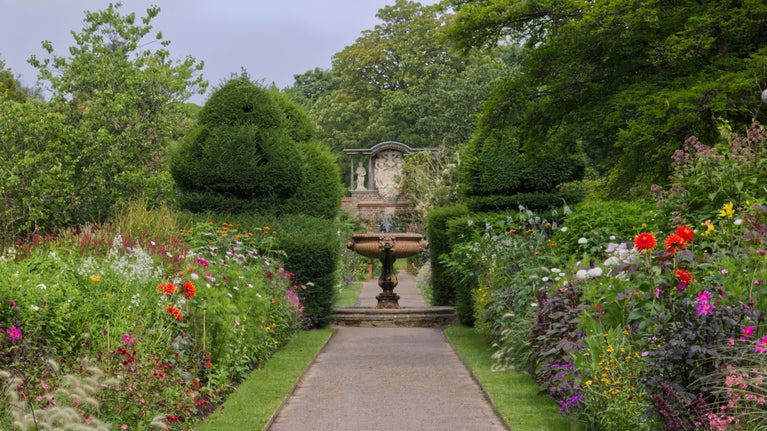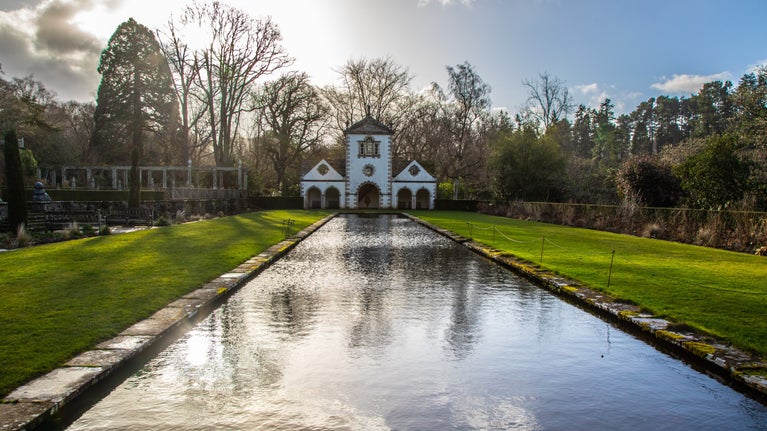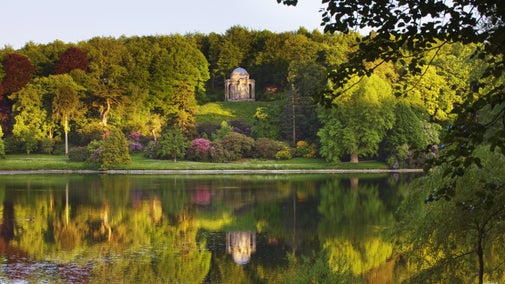
Gardens and landscapes
Find out more about the historical landscapes that the talented garden teams work hard to conserve at the places you love to visit.

From the self-sufficient gardens of the medieval period through to the low-maintenance, ornamental gardens of the 20th century, the fashions of each period in history greatly influenced garden design. Explore notable features of garden design during different periods in our history and discover where you can find examples of each at the places we care for.
(Middle Ages to 1500)
Medieval garden style was dominated by monasteries and manor houses. Herbs were grown for medicine and gardens were an important food source.
Gardens enclosed with wattle fences or quickthorn hedges
Trellis walkways and arbours providing shade and privacy
Raised beds to prevent plants becoming waterlogged
Grass treated as a flowery mead, planted with low growing wild flowers
Turf seats usually built against a wall with flowers planted in the grass
Physic gardens with regimented beds of medicinal herbs
Orchards providing apples for the kitchen and for making cider
Fishponds and stew ponds (where fish were purged of muddy water before cooking) to ensure a regular supply of protein during the many fast days of the Christian calendar
Dovecotes to provide pigeons for the kitchen, feathers for cushions and dung for fertilizing the garden
Pleasances, or ornamental parks for recreation, relaxation and sport
(1485 to 1603)
The influence of the Renaissance left its mark on the gardens of the Tudors, seen in the inclusion of architectural features. The most recognised feature from this period is the knot garden.
Knot gardens, geometric beds edged with a low hedge of box or other shrubs
Flowers such as violets, marigolds, and the rose cultivated not only for their beauty but for flavouring sweets and desserts
Mounts (artificial hills) to provide views of the garden and the landscape beyond
Banqueting houses to provide an intimate room for enjoying desserts and for entertainment
Fountains and automated water features to animate the garden, reflecting an interest in hydraulics
Deer parks to provide meat for the household as well as being a symbol of wealth and status
Symbolic devices and ornaments such as poles topped with colourful heraldic animals and labyrinths associated with religious or mythological significance
(1600 to early 1700s)
Gardens grew larger during the Stuart period as the influence of French and Dutch formal gardens brought features such as long avenues, terraces and topiary.
Formal layout influenced by the great gardens of France
Terraces controlling the irregular natural landscape
Parterres evolved from the Tudor knots
Avenues, an expression of welcome as well as status
Canals reflecting the fashion for all things Dutch at the end of the 17th century
Fountains and extravagant water displays to animate the gardens
Topiary, an expression of the ultimate control over nature
Woody places for intrigue and exercise
(1714 to 1830)
Gardens and parks merged into one during the 18th century to create a British style that would influence gardens across Europe. Many of the gardens we look after have features inspired by the European Grand Tour, which was popular in the Georgian period.
Informal layout designed as a classical Arcadia
Lakes created to reflect the landscape as well as for recreation
Cascades to add drama and animation
Temples, grottos and follies which doubled up as tea-rooms and viewing towers
Clumps and shelterbelts to provide shelter and privacy to the park
Shrubberies planted with newly introduced exotics from abroad
The ha-ha, an invisible boundary to keep livestock away from the house
Circuit walks taking you on a tour around the park
(1837 to 1901)
Exotic plants from around the world were brought home to gardens by Victorian collectors. The bright new colours were displayed in more formal garden styles during this period.
Plant collections gathered from all corners of the world
Arboretums to display collections of trees on a large scale
Flower beds in bright colours
Walled kitchen gardens using advanced technology to produce ever increasing ranges of fruits and vegetables
Advances in glasshouse technology enabling the most tender of plants to be cultivated at home
Rockeries inspired by expeditions to mountainous regions
Wild gardens, which were a backlash against the industrial world
Colour themed gardens reigned during this time and, as a backlash against the hardships of two world wars, gardens became increasingly ornamental and low maintenance, culminating in the 1970s craze for conifers and grasses.
However, as the century came to a close, the garden style became more relaxed with a new fashion for prairie planting and an interest in wildflower meadows, while many have rediscovered the joys of kitchen gardening and self-sufficiency.
Garden rooms to divide the garden into different themes
Cottage gardening, looking back to a less industrial age
Woodland gardens
Colour-coordinated borders influenced by artists such as Gertrude Jekyll
Perfect lawns thanks to improved lawnmower machinery and chemicals
Bedding as a direct result of the commercialisation of the nursery trade
Naturalistic prairie planting
Rose gardens as popular as ever

Find out more about the historical landscapes that the talented garden teams work hard to conserve at the places you love to visit.
The history of the English landscape garden is infused with political meaning. Learn the history and political stories behind this garden style characterised by structured informality.

Discover the evolution in garden buildings, from exclusive hothouses for rare new finds to the cornerstones of every garden today.

Open space campaigners sought to preserve countryside for recreation. Discover the history of the movement and how it inspired our work.

Tulips have been a popular flower for centuries. Find out where they came from, how they inspired the 'tulipmania' craze and learn about the different varieties you can still spot today.

Find out more about the picturesque aesthetic style and how it became a fashionable choice for wealthy estates in the 18th century. Discover more about the people who influenced the movement.

Discover some of the finest historic gardens in our care and how they were shaped by Victorian plant collectors, as they gathered plant species from across the globe.

Find out how water gardens have evolved with changing tastes, from European inspiration and ornamental canals to the water feature in your garden today.

Explore Claremont Landscape Garden in Surrey in our podcast episode 'A garden fit for Bridgerton' to uncover historic parties described as the lovechild of a music festival and a garden party. You can also find more episodes from series seven, filled with nature and history.
